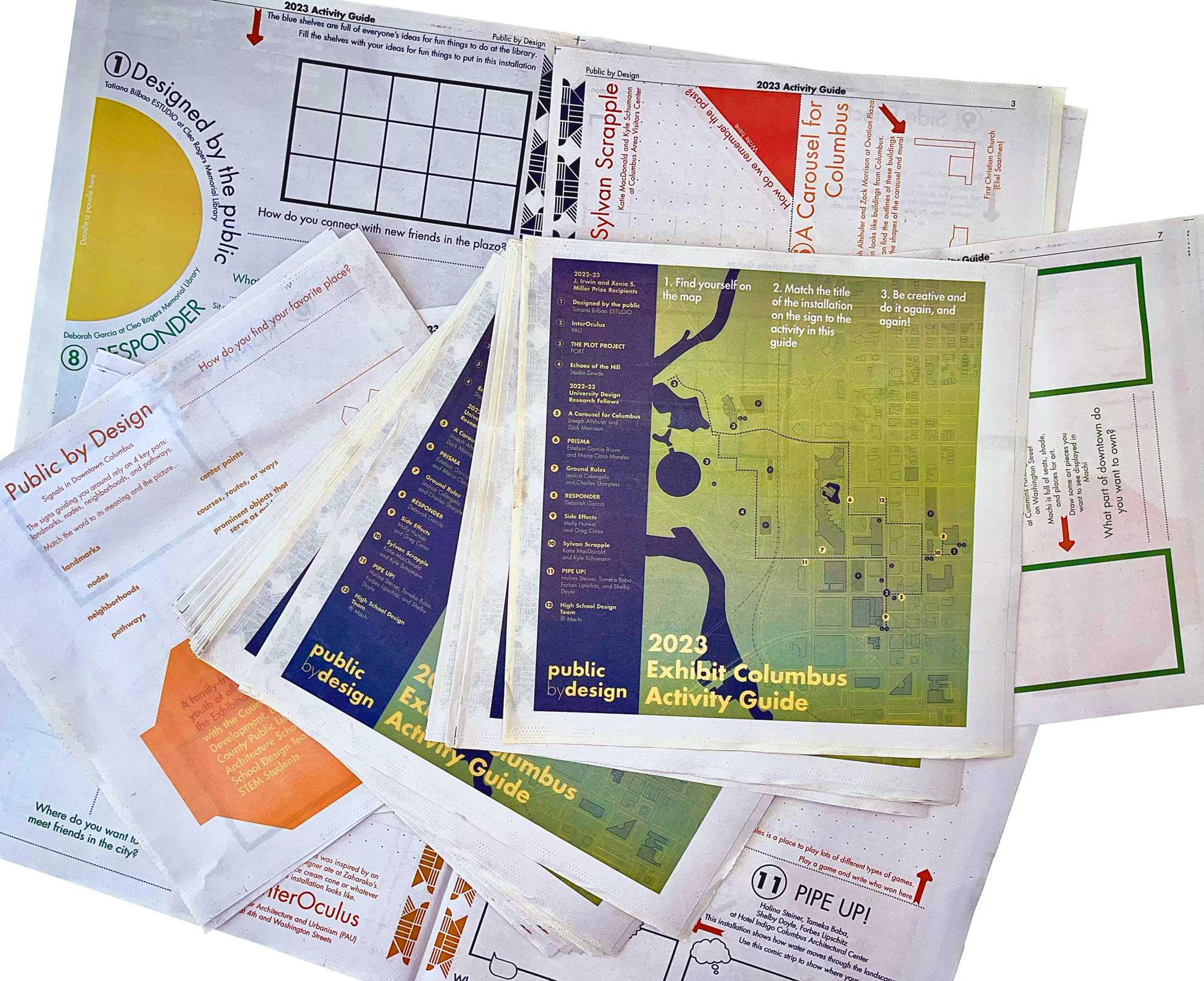
UDRF
●
Esteban Garcia Bravo and Maria Clara Morales
●
PRISMA
●
Presented by Columbus Area Visitors Center
●
UDRF ● Esteban Garcia Bravo and Maria Clara Morales ● PRISMA ● Presented by Columbus Area Visitors Center ●
PRISMA is an interactive and immersive light installation that invites you to re-activate “invisible” urban spaces with renewed excitement.
Inspired by Columbus' modern architectural legacy, a rectangular prism is used as a foundation to create an open-air tunnel with a free-flowing, animated lighted experience. Walking through PRISMA, the entire space comes alive with animated lights, each color vibrantly playing off the next. Every color is possible inside PRISMA, and each unique color represents the coexistence of people and communities that share these urban spaces. PRISMA even offers public access to set a particular mood for the prism!
This installation offers a public place to reconnect and celebrate the colorful diversity of life. In collaboration with various community groups, PRISMA serves as an energizing venue to enjoy light performances and pop-up events celebrating music, art and culture, and much more.
Accessibility
The exhibit space is fully accessible and can be viewed from the sidewalk. The installation features motion lighting and is most actively visible at night.
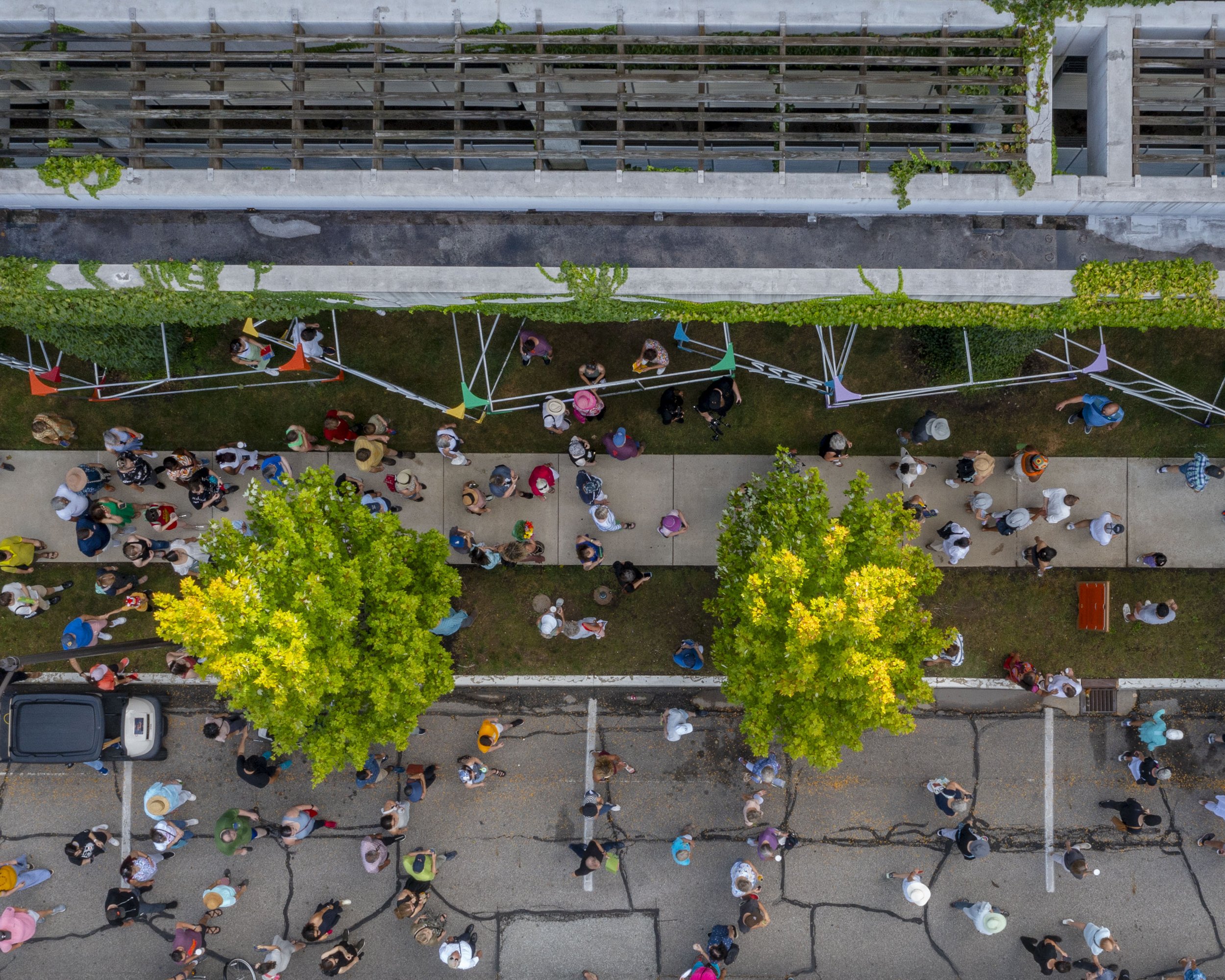
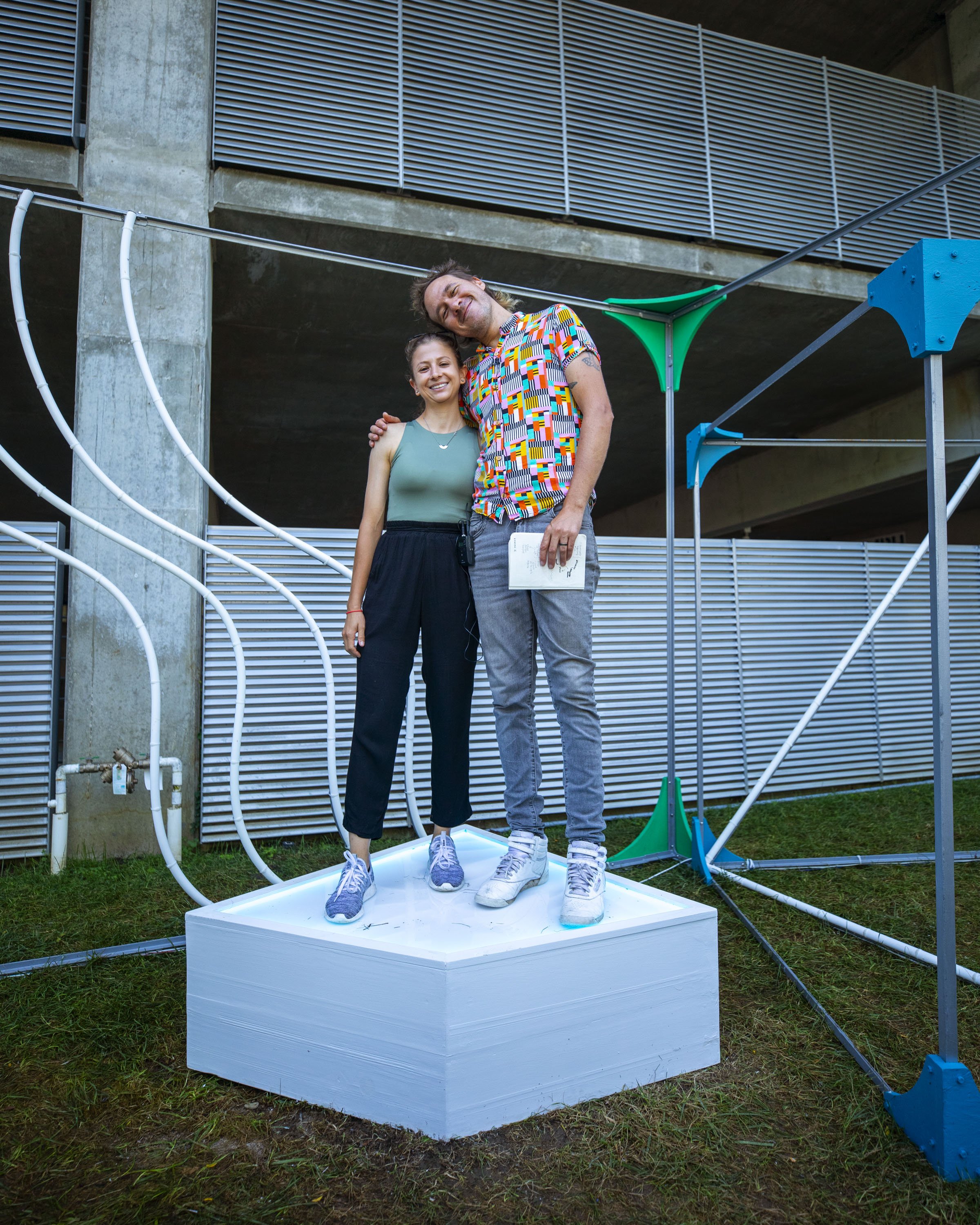
How do we activate space?
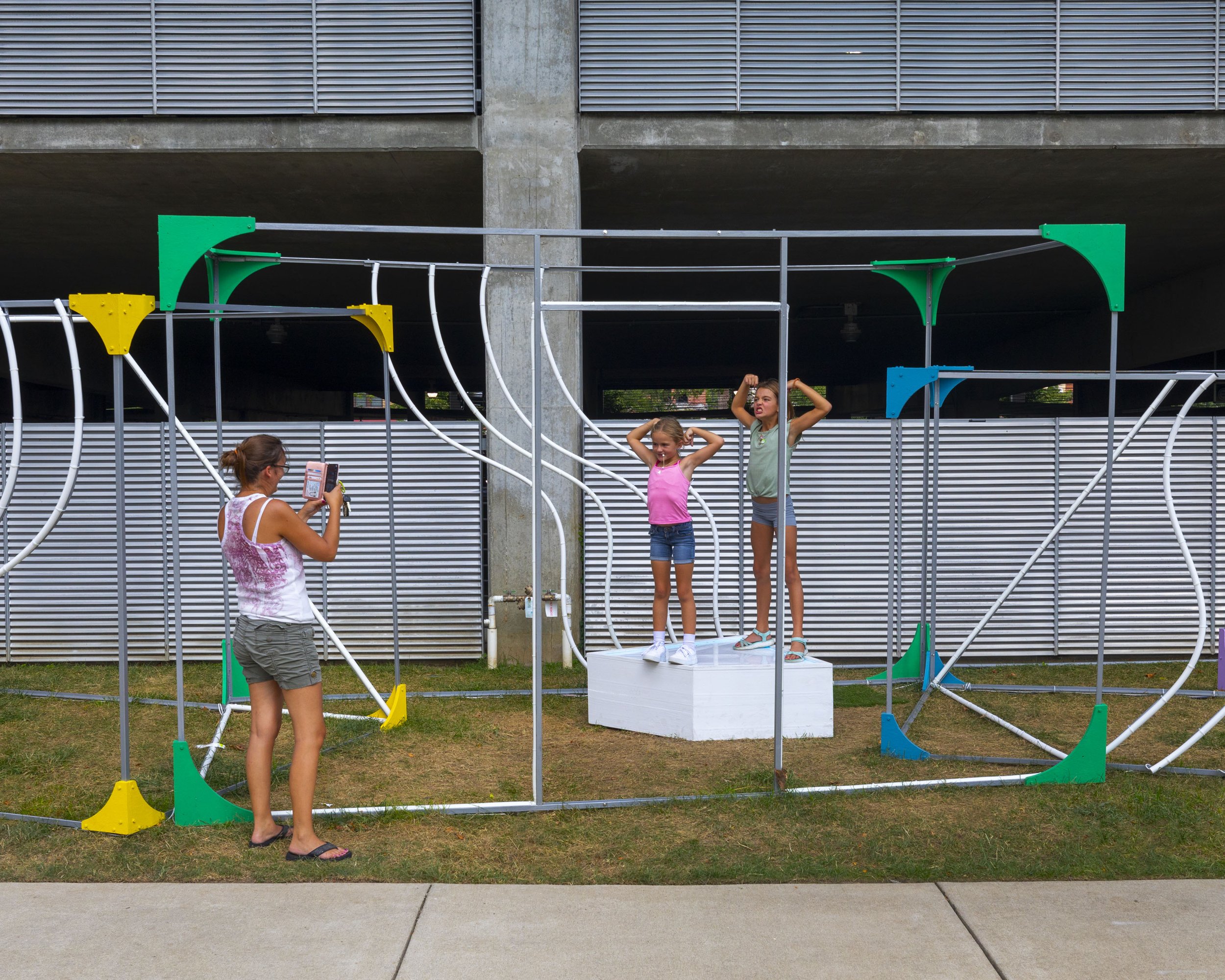
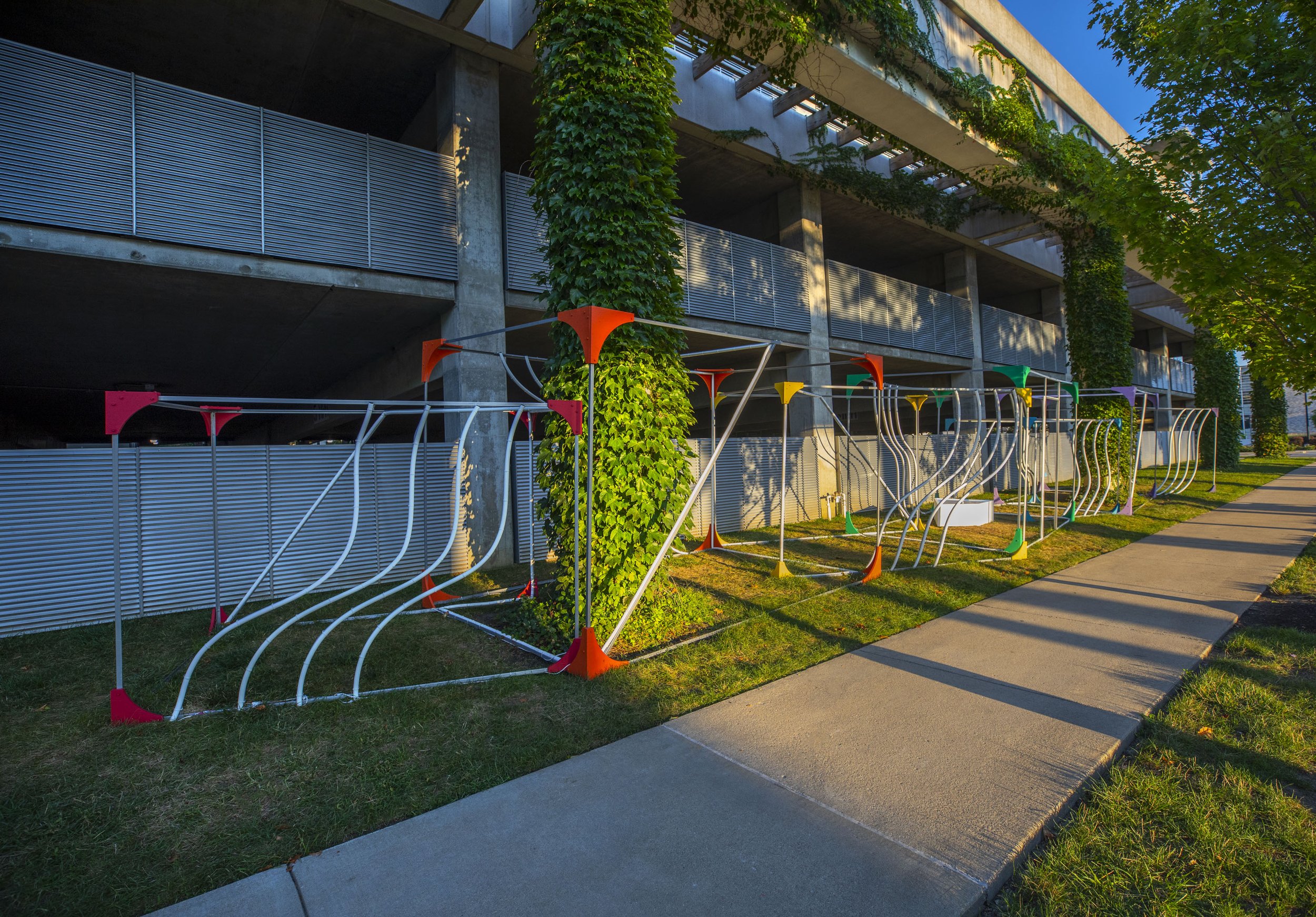
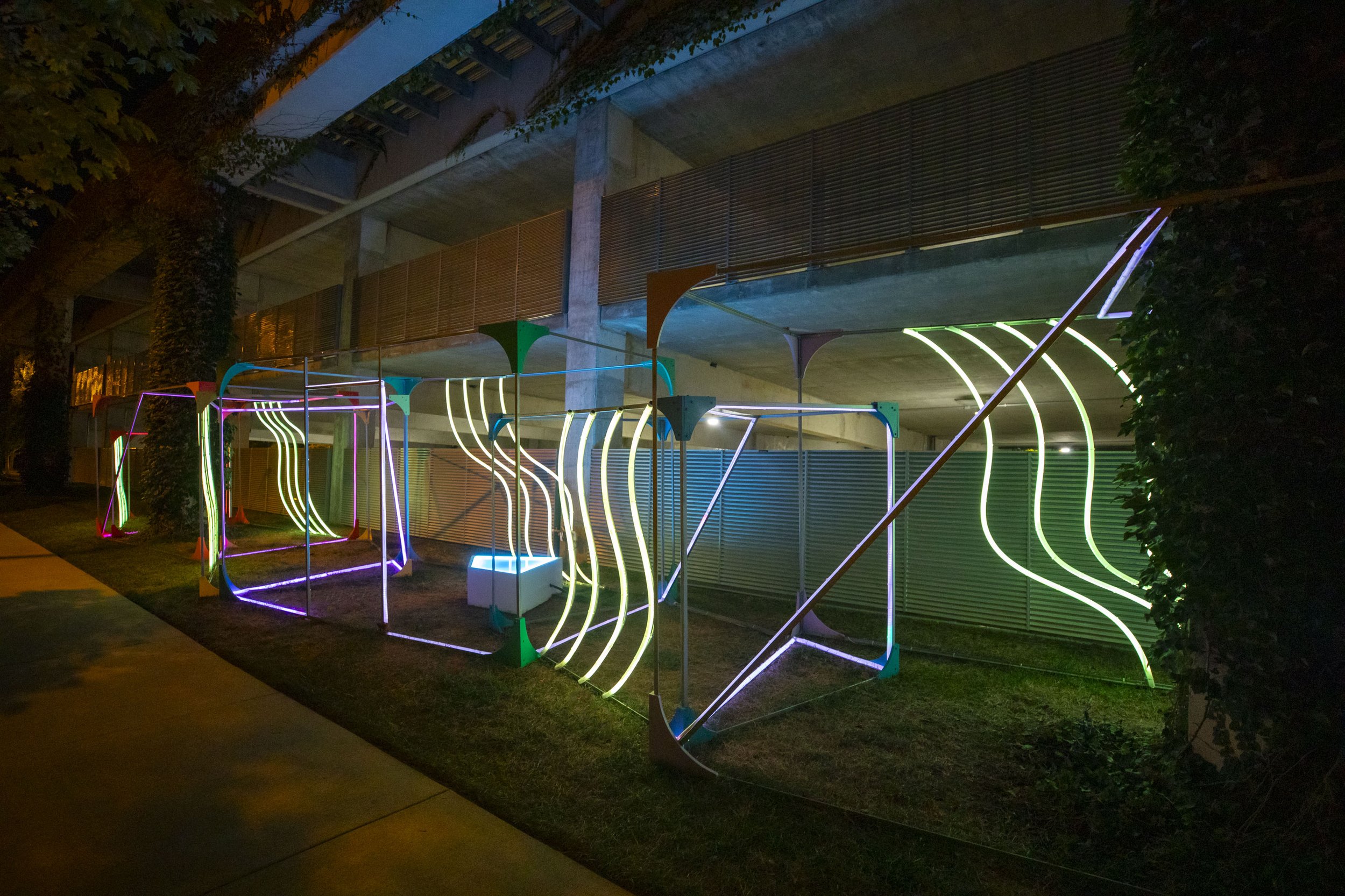
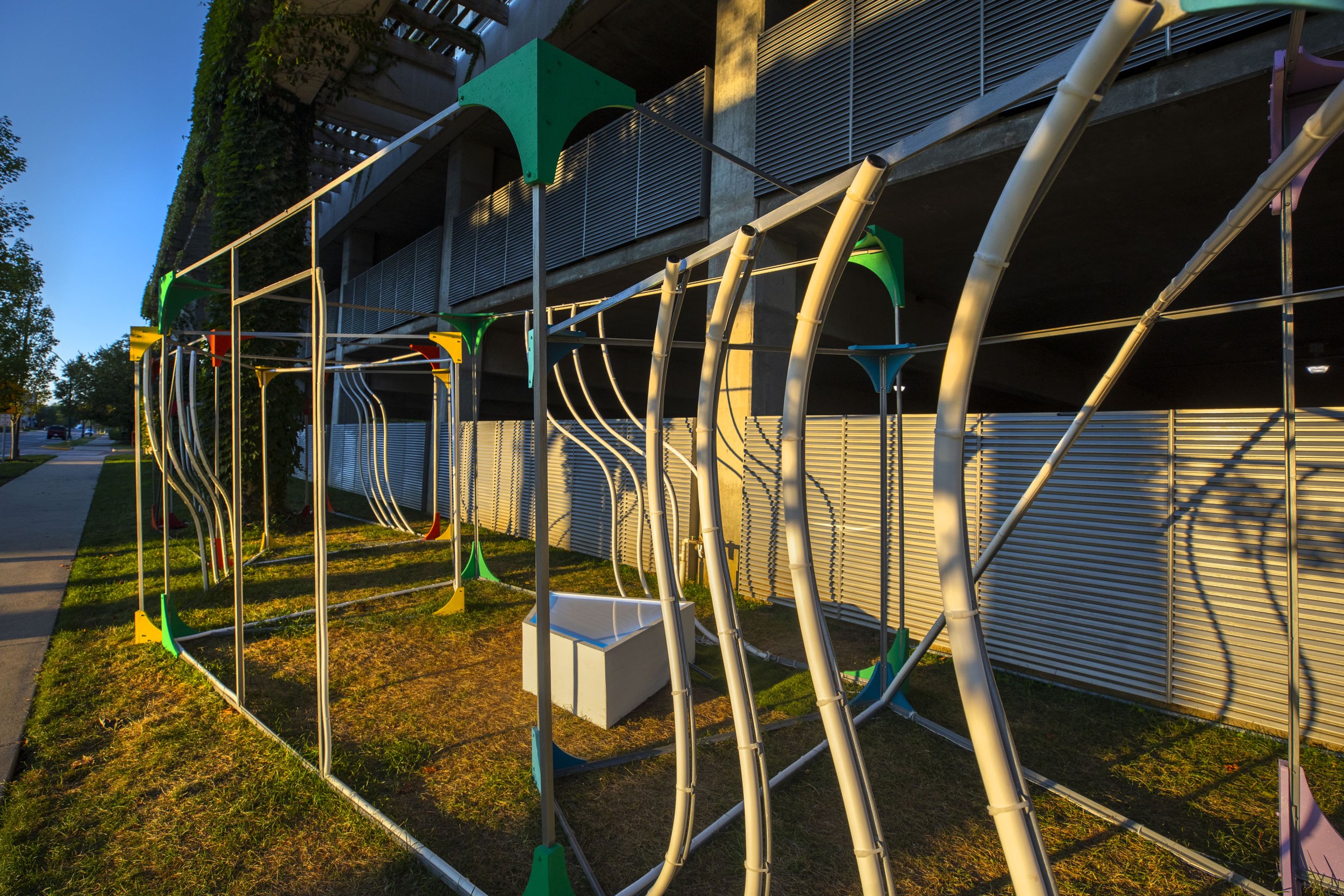
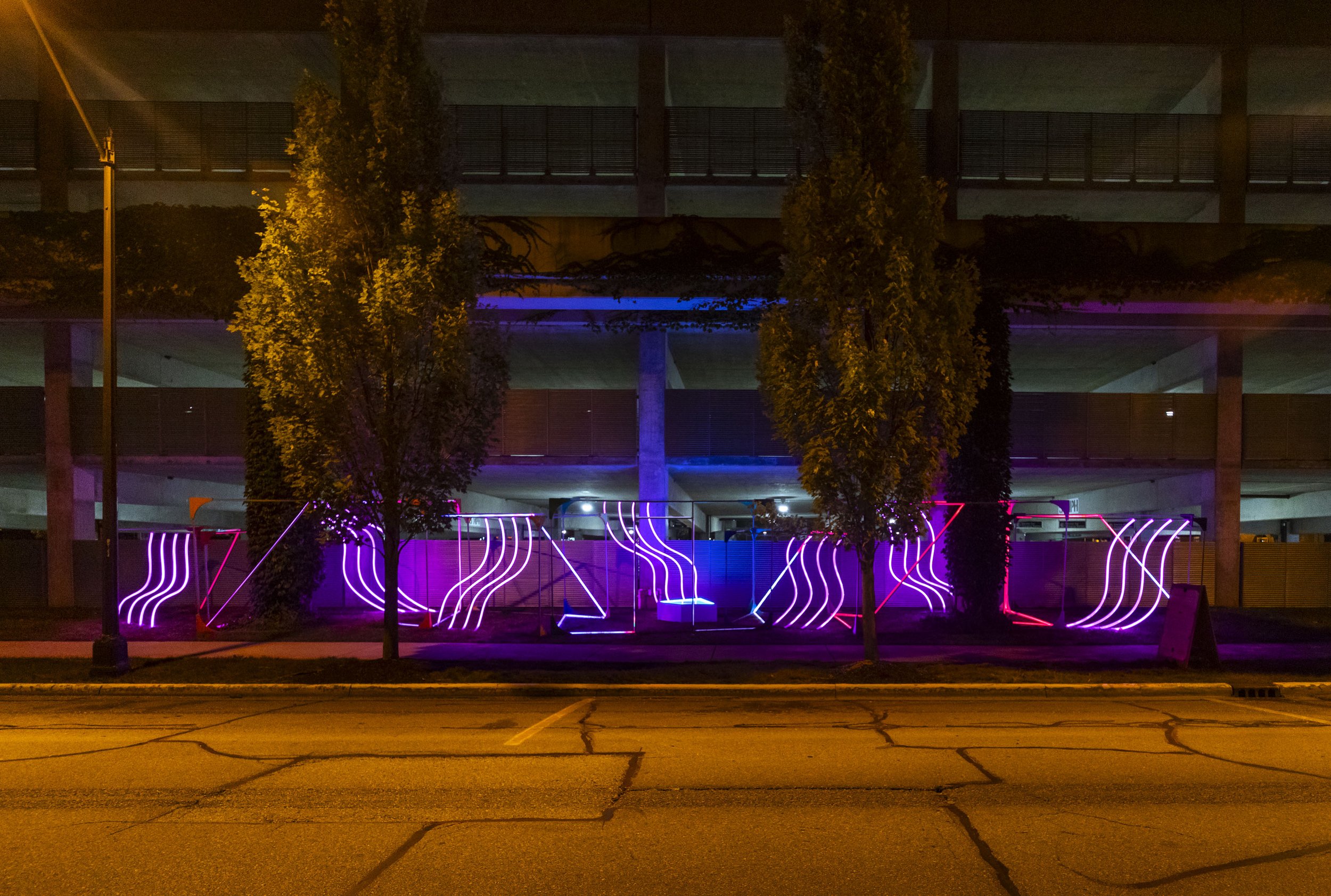

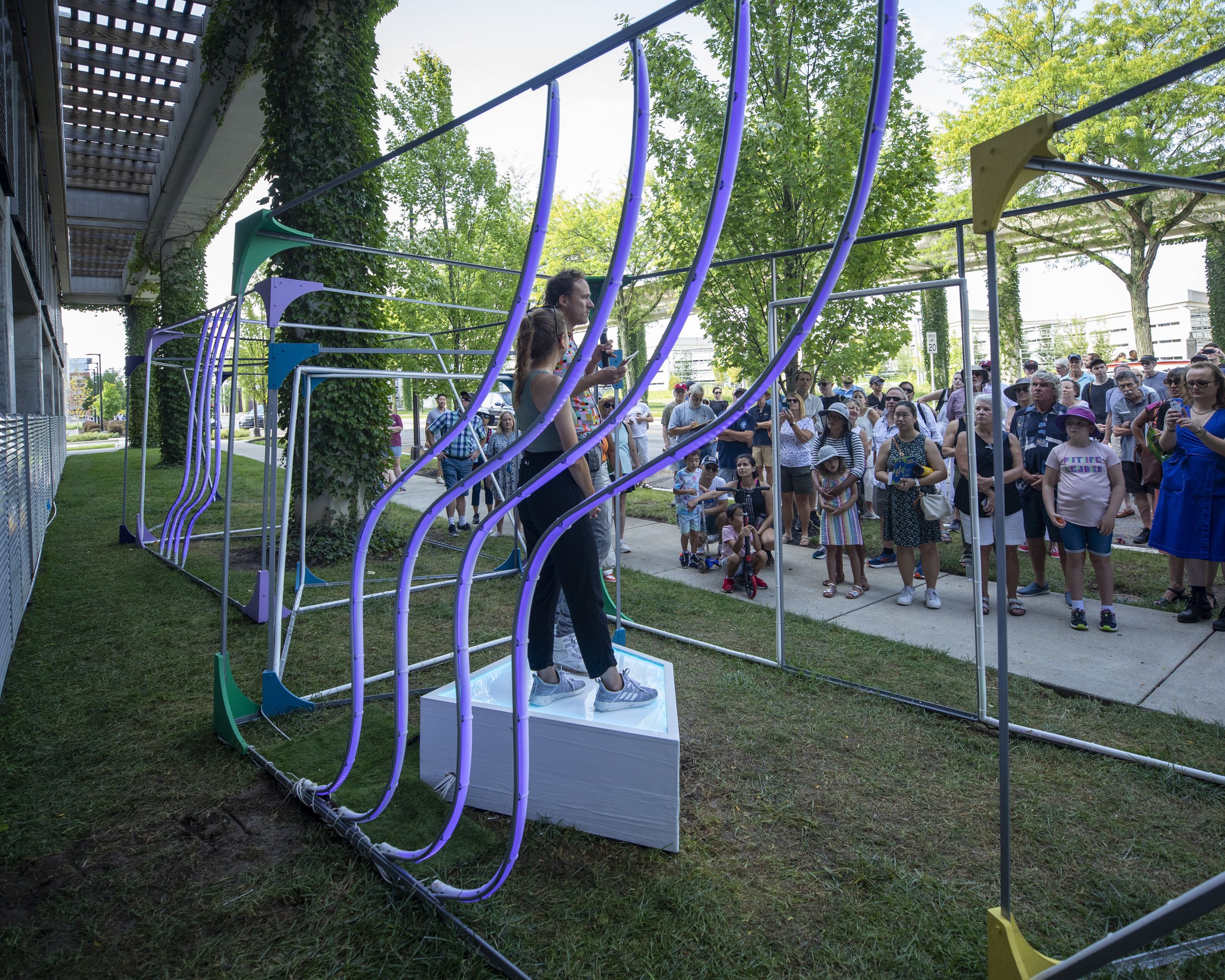
PRISMA Installation Credits
University Design Research Fellowship
Presented by
Columbus Area Visitors Center
Site Collaborator
Cummins Inc.
University
Department of Computer Graphics Technology at Purdue University
Team
Esteban Garcia Bravo, Project manager, fabricator
Maria Clara Morales, Designer, fabricator
Luke Gumaelius, Fabrication consultant, fabricator
Jack Thompson, Welder
Nick Wacyk, Electronics and interactivity consultant, fabricator
Pablo Garcia, 3d printing consultant, fabricator
Davin Huston, Electronics and interactivity consultant
Jose Manuel Garcia Bravo, Engineering consultant, 3d printing consultant
Materials
Steel, PEX, Wood, Advantech, Acrylic, LED lights
Fabrication Supporters
Max Carlson
Dor Ben-Amotz
Michael Amato
Dan Bollock & Dave McMillan- Bechtel Innovation Center
Nandi Marocco
Additional Credits
Julian Triveri, 3d rendering
William Yang, 3d modeling
Site: Cummins Parking Garage West
Curatorial Question
How do we activate space?
“Exhibit Columbus has made them reflect on how intervening in public spaces can bring them to life and positively affect the people and communities that inhabit them.”
Maria Clara Morales and Esteban Garcia Bravo worked together to create PRISMA, each bringing different backgrounds and a wealth of knowledge, experience, and skills to the project.
Esteban has had a passion for making art since he was a child, spending many years of his childhood drawing comics, building models, and using an early Commodore VIC 20 to code pictures and animations. He did his undergraduate work in his hometown of Bogotá, Colombia, and then came to Indiana in 2005 and began working as a professor at Purdue University in 2013.
He said it took several years to realize what kind of art he wanted to make. Then about 12 years ago, he wanted to create an installation that embedded animated light sequences and selected a colorful LED strip. That led him to collaborate with artist Max Carlson to build light sculptures with wood that they have shown internationally. After showing artwork in galleries, museums, media art festivals, and pop-up events, he realized that art in public spaces was his favorite.
Esteban and Maria both said working with metal has been the biggest challenge. The work has been extremely physical, but they have both liked learning to work with steel. Esteban said he feels proud of this work because it is made with their hands. After this project, he wants to experiment more with the materials that they have discovered.
Maria is the child of a doctor father who is passionate about carpentry and automobile mechanics. Her mother, a dentist, loves to paint and make crafts. Raised as a maker and builder, she has had a passion for puzzles and creation since she was a child, making everything by hand before learning digital technologies.
During her studies, Maria took many courses besides her major that formed her in a multidisciplinary way. She has said yes to many unconventional opportunities that have come along without a clear idea of what would happen next. So far, this journey has taken her in unexpected but incredible directions.
She said the design process has enabled them to transform their ideas into buildable working components. Collaborating with Esteban has been an exciting process filled with rich dialogue and innovative problem-solving.
Maria said that she has found PRISMA to be a meeting point for architecture, design, and art, inspired by the repetition of simple geometries or “modularity” often used in modern architecture.
She comes from an architectural background whereas Esteban comes from art, which has caused them to pull one another in opposite directions, which has enriched their process and their product by pushing each of them beyond their comfort zones to make the best decisions possible.
This excerpt is from the 2023 Field Guide. Download it here.
Activity Guide for kids and families to explore the Exhibition.
Download the activity for the installation PRISMA. Print at home, or stop by any Infohub to pick up a free guide.
2023 Design Presentations
PRISMA installation design concept by 2022–23 University Design Research Fellows Esteban Garcia Bravo and Maria Clara Morales from Department of Computer Graphics Technology at Purdue University in West Lafayette, Indiana.
“I have visited Columbus many times to admire its wonderful architecture. I am a modern lover, and I love the dialog between modernist and contemporary aesthetics. To me, participating in this program is a dream come true!” — Esteban Garcia Bravo (with Maria Clara Morales)
University Design Research Fellowship
Esteban Garica Bravo and Maria Clara Morales
Department of Computer Graphics Technology at Purdue University
West Lafayette, Indiana
Esteban Garcia Bravo is Associate Professor in the department of Computer Graphics Technology at Purdue University, where he teaches digital imaging, fabrication and computational aesthetics. He is a Colombian-American artist and scholar exploring computational arts that earned his MFA from Purdue University in 2008, and a PhD in Technology, also from Purdue, in 2013. His research on computer art heritage and digital media art practices has been featured in the annual meetings of international organizations and his artwork has been displayed internationally in media art festivals, gallery exhibits, museums, public art installations, and artist-in-residence programs.
Maria Clara Morales is a Research Scholar at Purdue University, where she is focusing on developing physical and digital components of interactive art installations under the mentorship of Esteban and Davin Huston. She has extensive knowledge in 3D modeling and rendering, digital fabrication, and interactive multimedia programming. She is currently living in Bogotá, Colombia and working in interior design and furniture manufacturing.
Existing work by Esteban Garcia Bravo with Maria Clara Morales
Geode (2016) Dimensions: (w)12’ x (d)13’ x (h)10’ A project by Carlson Garcia Collective (Esteban Garcia Bravo, Max Carlson, and Aaron Zernack). Video Projectors, Speakers, Computers, Live performance, CV synthesizers, Fabric, and Galvanized Steel. Installed temporarily at the Tippecanoe County Amphitheater.
Aurora Almanac (2021) Overall project area: 216 Sq. ft. - 2 panels (8’x6’) and 5 panels (6’x4’), HDU Foam, Aluminum, LEDs, User interface. Installed at Trades District Garage, Bloomington, Indiana.
Geode CTAC (2019), (w)50’ x (d)1 ’ x (h)13’, A project by Carlson Garcia Collective (Esteban Garcia Bravo, Max Carlson, and Aaron Zernack). Cardboard, Mylar, Video projectors, Speakers, Computer. Installed temporarily at Crooked Tree Arts Center, Petoskey, MI.









